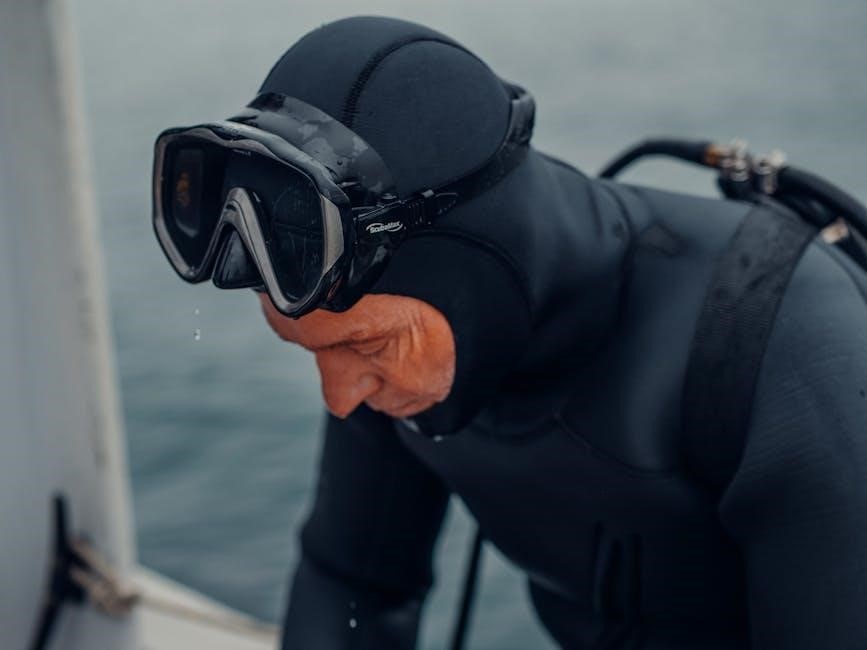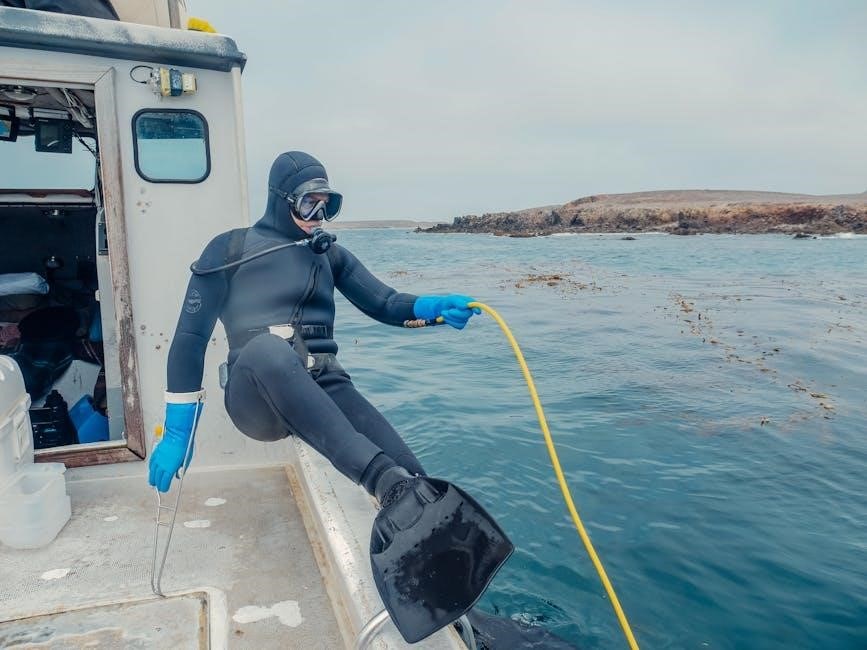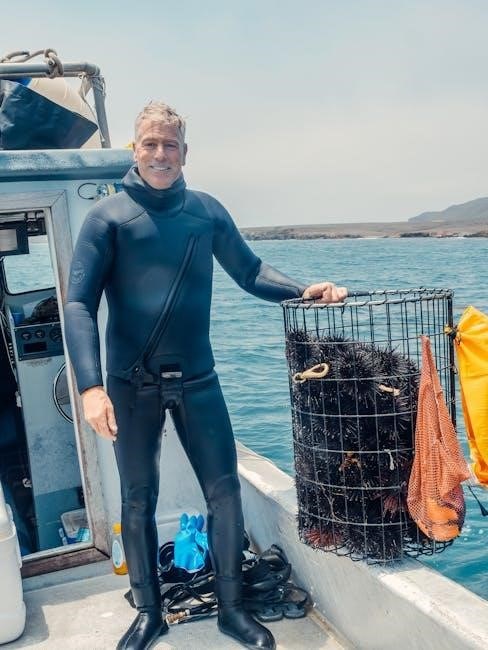Scuba diving requires proper gear‚ including wetsuits with suitable thickness‚
to ensure diver safety
and comfort during underwater activities‚ with various factors influencing the choice of wetsuit thickness always considered.
Importance of Wetsuit Thickness in Scuba Diving
The importance of wetsuit thickness in scuba diving cannot be overstated‚ as it plays a crucial role in maintaining the diver’s comfort and safety during underwater activities. A wetsuit with the correct thickness helps to regulate the diver’s body temperature‚ preventing hypothermia and heat exhaustion. The thickness of the wetsuit also affects the diver’s buoyancy and mobility‚ making it essential to choose the right thickness for the specific diving conditions. Furthermore‚ a wetsuit with the correct thickness can also help to prevent injuries and reduce the risk of decompression sickness. By selecting a wetsuit with the appropriate thickness‚ divers can ensure a safe and enjoyable diving experience. The correct wetsuit thickness is essential for scuba diving‚ and divers should carefully consider this factor when choosing their gear. This is a critical aspect of scuba diving safety and comfort.

Factors Affecting Wetsuit Thickness
Water temperature and activity type are key factors affecting wetsuit thickness always considered carefully.
Water Temperature and Wetsuit Thickness
Water temperature plays a significant role in determining the ideal wetsuit thickness for scuba diving‚ as it affects the amount of thermal protection needed. Generally‚ warmer waters require thinner wetsuits‚ while colder waters require thicker ones; A wetsuit thickness guide can help divers choose the right suit for their needs. The guide typically provides a range of water temperatures and corresponding wetsuit thicknesses. For example‚ water temperatures above 59F (15C) may require a wetsuit thickness of 3mm‚ while temperatures below 50F (10C) may require a thickness of 7mm or more. By considering water temperature‚ divers can ensure they have the right amount of thermal protection and comfort during their dive. This is crucial for a safe and enjoyable scuba diving experience. The relationship between water temperature and wetsuit thickness is a key consideration for divers.
Activity Type and Wetsuit Thickness
The type of activity being performed also influences the choice of wetsuit thickness‚ as different activities have varying levels of physical exertion and exposure to the water. For example‚ scuba diving typically requires a thicker wetsuit than snorkeling or swimming‚ due to the longer duration and deeper depths involved. Additionally‚ the level of movement and flexibility required for the activity can also impact the choice of wetsuit thickness. A thicker wetsuit may be more suitable for activities that involve minimal movement‚ while a thinner wetsuit may be preferred for activities that require more flexibility. By considering the type of activity‚ divers can choose a wetsuit that provides the right balance of warmth‚ flexibility‚ and protection. This helps to ensure a safe and comfortable experience. The activity type is an important factor in selecting the appropriate wetsuit thickness.

Wetsuit Thickness Guide by Water Temperature
Water temperature determines the ideal wetsuit thickness for scuba diving‚ with colder waters requiring thicker suits for warmth and comfort always.
Warm Water Wetsuit Thickness
For warm water scuba diving‚ a thinner wetsuit is suitable‚ typically ranging from 1 to 3 millimeters in thickness‚ providing adequate protection and flexibility.
In tropical waters‚ divers often prefer a wetsuit with a thickness of 1 to 2 millimeters‚ allowing for greater freedom of movement and comfort.
The warm water wetsuit thickness guide recommends a 2-millimeter full suit or a 1-millimeter shorty for water temperatures above 73 degrees Fahrenheit.
Divers should consider the specific water conditions and their personal comfort level when selecting a wetsuit thickness for warm water diving.
A wetsuit that is too thick can cause overheating‚ while one that is too thin may not provide sufficient protection.
By choosing the right wetsuit thickness‚ divers can ensure a safe and enjoyable experience in warm water conditions.
The key is to find a balance between protection and flexibility‚ allowing for a comfortable and successful dive.
Warm water wetsuit thickness is an essential consideration for scuba divers‚ and selecting the right thickness can make all the difference in their diving experience.
Cold Water Wetsuit Thickness
In cold water scuba diving‚ a thicker wetsuit is necessary to maintain body heat and prevent hypothermia.
A wetsuit with a thickness of 5 to 7 millimeters is commonly used in cold water conditions‚ providing adequate insulation and protection.
The cold water wetsuit thickness guide recommends a 5-millimeter full suit or a 7-millimeter semi-dry suit for water temperatures below 50 degrees Fahrenheit.
Divers should consider the specific water conditions‚ including temperature and currents‚ when selecting a wetsuit thickness for cold water diving.
A wetsuit that is too thin can lead to heat loss‚ while one that is too thick can restrict movement and cause discomfort.
By choosing the right wetsuit thickness‚ divers can ensure a safe and successful dive in cold water conditions.
The key is to find a balance between warmth and flexibility‚ allowing for a comfortable and enjoyable experience.
Cold water wetsuit thickness is a critical factor in scuba diving‚ and selecting the right thickness can make a significant difference in diver safety and comfort.

Common Wetsuit Thicknesses
Standard wetsuit thicknesses include 3mm‚ 5mm‚ and 7mm options‚ each suitable for different water temperatures and diving conditions always considered carefully by divers using them.
3mm‚ 5mm‚ and 7mm Wetsuit Thicknesses
The most common wetsuit thicknesses used by scuba divers are 3mm‚ 5mm‚ and 7mm‚ each providing a different level of thermal protection and flexibility.
A 3mm wetsuit is suitable for warm water diving‚ while a 5mm wetsuit is suitable for temperate waters‚ and a 7mm wetsuit is suitable for cold water diving.
These thicknesses are widely available and can be used for various diving activities‚ including recreational and technical diving.
Divers can choose the appropriate thickness based on the water temperature and their personal preference for comfort and flexibility.
The 3mm‚ 5mm‚ and 7mm wetsuit thicknesses are popular among scuba divers due to their versatility and effectiveness in providing thermal protection.
They are also relatively affordable and can be easily found at most dive shops and online retailers‚ making them a great option for divers of all levels.
Overall‚ the 3mm‚ 5mm‚ and 7mm wetsuit thicknesses are a great choice for scuba divers who want a reliable and comfortable wetsuit for their diving needs.

Selecting the Appropriate Wetsuit Thickness
Proper wetsuit thickness selection is crucial for scuba diving comfort and safety always considered by divers.
Comfort and Safety Considerations
Comfort and safety are essential considerations when selecting a wetsuit thickness for scuba diving. A wetsuit that is too thin may not provide adequate thermal protection‚ while a wetsuit that is too thick may restrict movement and cause discomfort. Divers must consider the water temperature‚ their personal comfort level‚ and the type of diving they will be doing when choosing a wetsuit thickness. A wetsuit that is properly fitted and suitable for the diving conditions can help prevent hypothermia‚ improve buoyancy‚ and reduce fatigue. By considering these factors‚ divers can ensure a safe and comfortable diving experience. The wetsuit thickness guide provides a general outline for selecting the appropriate wetsuit thickness‚ but divers should also consider their individual needs and preferences. Proper wetsuit selection is crucial for a successful and enjoyable scuba diving experience‚ and comfort and safety considerations should always be prioritized.
Proper wetsuit thickness selection is crucial for scuba diving‚ ensuring safety and comfort always.
